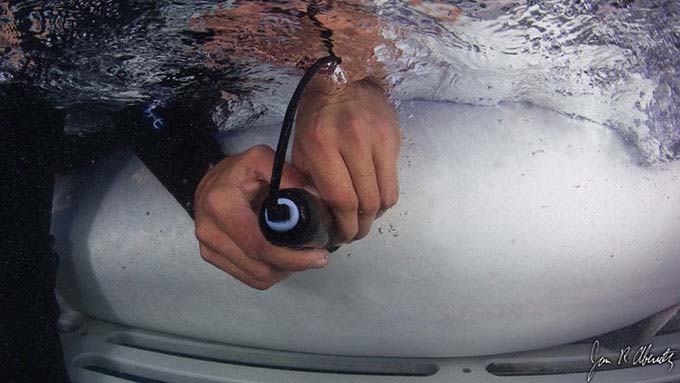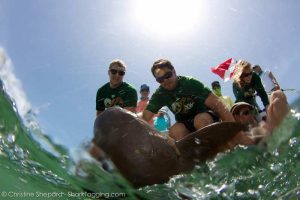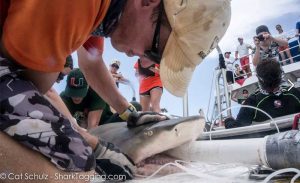

Shark expert Neil Hammerschlag administers ultrasounds on sharks at Tiger Beach in the Bahamas.
Moving swiftly and acting a bit moody, the large pregnant female showed up for her ultrasound without a scheduled appointment.
That didn’t matter to the doctor, Neil Hammerschlag. If there’s one thing he’s learned from years of fieldwork, it is to expect the unexpected.
Hammerschlag is actually a doctor of philosophy—a research assistant professor at the University of Miami’s Rosenstiel School of Marine and Atmospheric Science. And the large pregnant female in this case is a 10-foot, 850-pound tiger shark inhabiting the waters of Tiger Beach, Bahamas.
Using the same imaging technology as that employed by medical professionals on pregnant women, Hammerschlag has teamed with scientists from the University of New England to capture detailed images of the reproductive organs of female tiger sharks, revealing the presence of pups in the womb without having to kill the sharks to conduct such research.
About the Photo
Neil Hammerschlag of the Rosenstiel School leads shark tagging trips in the waters off South Florida, and also examines pregnant sharks at Tiger Beach, Bahamas.
Join the Conversation:
Follow on
Twitter:
UM Rosenstiel School of Marine and
Atmospheric Science, @UMiamiRSMAS
University of
Miami, @univmiami
UM News, @univmiaminews
“We don’t know a lot about the reproductive system of this species,” says Hammerschlag, who has studied all kinds of sharks and has appeared on multiple episodes of the Discovery Channel’s Shark Week, an annual weeklong series of programming dedicated to all things sharks. “So it’s a bit of a holy grail in terms of understanding the biology of these animals—where they mate, where they gestate, where they give birth.”
Data from the ultrasounds, performed at sea on sharks lured and captured using bait traps, reveal that Tiger Beach is important for female tiger sharks of different life stages, and that a high proportion of the sharks were pregnant during winter months. Data also suggests that Tiger Beach “may function as a refuge habitat for females to reach maturity as well as a gestation ground where pregnant females benefit from calm, warm waters year round that help incubate the developing embryos and speed up gestation,” says Hammerschlag, noting that his research team also took blood samples for hormone analysis.
Marine scientists from the University of Miami and the University of New England conduct shark research in The Bahamas and the Caribbean by giving sonograms to females and monitoring their pups.

Populations of many migratory marine predators such as sharks are experiencing large declines across the globe and fishing aggregations of pregnant females can significantly impact the health of local and regional populations. Tiger Beach is located within the Bahamas Exclusive Economic Zone, where shark fishing has been prohibited since 2011. The relatively high abundance of tiger sharks in the Bahamas compared to the rest of the Caribbean where populations are much lower could be attributed in part to the protection of mature and gravid females in the Bahamas shark sanctuary.
“It is crucial for marine biologists to understand their behaviors to provide information for resource managers to effectively protect and manage them,” says Hammerschlag.
- ROBERT C. JONES JR. / UM News





